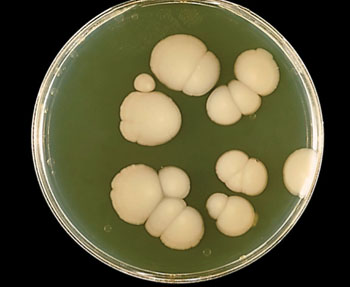Chemical Sensor Rapidly Detects Fungal Infections
By LabMedica International staff writers
Posted on 19 May 2016
An elevated concentration of D-arabitol, a simple sugar alcohol, in urine, especially compared to that of L-arabitol or creatinine, is indicative of a fungal infection, which can become deadly.Posted on 19 May 2016
In healthy humans these forms, known as D-arabitol and L-arabitol, are formed in roughly the same amounts; however, cells of Candida species produce only D-arabitol. The relative increase in the concentration of this enantiomer in body fluids can therefore herald infection.

Image: Candida albicans growing on Sabouraud agar (Photo courtesy of Dr. William Kaplan / CDC).
Scientists at the Institute of Physical Chemistry of the Polish Academy of Sciences (Warsaw, Poland) devised, fabricated, and tested chemical sensors determining D-arabitol. These chemosensors comprised the quartz crystal resonator (QCR) or extended-gate field-effect transistor (EG-FET) transducers integrated with molecularly imprinted polymer (MIP) film recognition units.
The polymer film with molecular cavities binding D-arabitol was prepared using the molecular imprinting technique. The process began by dissolving D-arabitol in acetonitrile. Then boric acid labeled with bithiophene, whose molecules bound to the D-arabitol in particular positions, was added to the solution. The bithiophene substituent permitted the electrochemical polymerization of the solution. A polymer film having a rigid structure was thus created, from which all that was needed was to rinse out the D-arabitol molecules to obtain a film with molecular cavities of the desired shape and properties.
The detection polymer films produced a thickness of about 200 nanometers. They are deposited either on gold electrodes, or on quartz resonators. After immersing a sample taken from a patient in the solution, D-arabitol particles get stuck in the molecular cavities of the films and depending on the method of detection, either change the flow of current through a field-effect transistor having a gate connected to an electrode or the oscillation resonance frequency of a piezoelectric resonator. The chemical sensor enabled the detection time of fungi to be shortened from the current couple of days to just a few minutes.
With the QCR and EG-FET chemosensors, the D-arabitol concentration was determined under flow-injection analysis and stagnant-solution binding conditions, respectively. Selectivity with respect to common interferences, and L-arabitol in particular, of the devised chemosensors was superior. Limits of detection and linear dynamic concentration ranges of the QCR and EG-FET chemosensors were 150 µM and 150µM to 1.25 mM as well as and 120 µM to 1.00 mM, respectively, being lower than the d-arabitol concentrations in urine of patients with invasive candidiasis, which was greater than 220 μM. The authors concluded that the devised chemosensors are suitable for early diagnosis of fungal infections caused by Candida sp. yeasts. The study was published in the May 2016 issue of the journal Biosensors and Bioelectronics.
Related Links:
Institute of Physical Chemistry of the Polish Academy of Sciences













